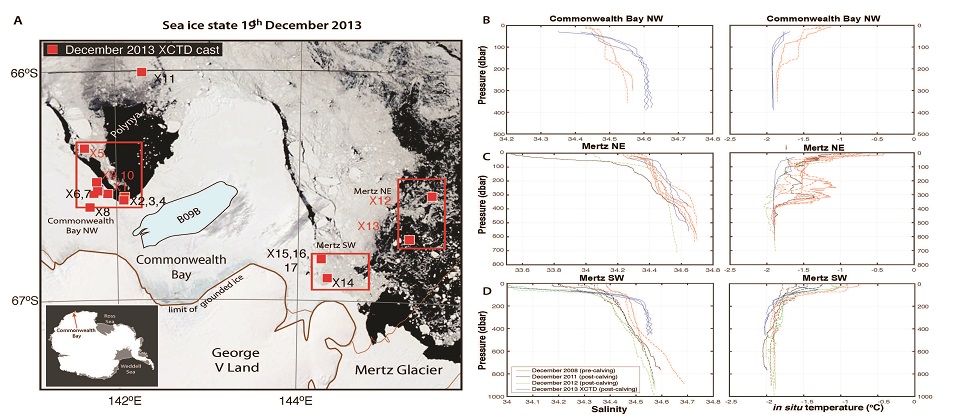
Commonwealth Bay in the East Antarctic will be forever associated with Sir Douglas Mawson’s pioneering scientific venture a century ago: the Australasian Antarctic Expedition. Mawson’s team had only intended to spend one year south, but it was not to be. A sudden turn of events led to tragedy on the ice, the deaths of two men, allegations of cannibalism and, with the return of winter sea ice, an extended stay in Antarctica. While the efforts of Mawson and his men laid the foundations for modern Antarctic science, the region has continued to experience dramatic change. And it doesn’t get any more dramatic than the arrival of iceberg B09B in 2010.
The word ‘berg’ doesn’t really do it justice though – B09B is a monster. Weighing in at an estimated 500 billion tonnes, this block of ice is 97 miles long and over 20 kilometres wide. There’s enough freshwater in B09B to provide all of New York’s drinking needs for 300 years. And it started out even larger. In 1987, an iceberg the size of Bali broke free from the continent in the Ross Sea. It was one of the largest bergs ever seen. Riding the westward-flowing ocean currents, the Ross Sea berg smashed its way along the coast. By the time it reached Commonwealth Bay, the largest remaining part was labelled with the unassuming moniker B09B, and in 2010 in smashed spectacularly into the 100km long floating tongue of the Mertz Glacier, changing regional ocean circulation and leading to a massive regional reconfiguration, with possible global implications which is still ongoing today.
Normally, chilling Antarctic winds blow off the continent year round, freezing the surface of Commonwealth Bay, regardless of whether it’s winter or not: the sea ice is formed, blown offshore, a new open area of water known as a polynya is formed, and more seawater is frozen in its place. As sea ice is created offshore, a fundamental process takes place below the surface. The salt in ocean water is effectively squeezed out of the ice creating a dense mass of water. In most of the Southern Ocean, this cold, super-salty water just diffuses away. In Commonwealth Bay, however, the conditions are perfect for the formation of something known as Antarctic Bottom Water (AABW), a super cold water mass that forms a key part of the world’s ocean circulation system. Worryingly, some scientists have suggested the arrival of B09B may have slowed Antarctic Bottom Water production, with potentially global implications.
As part of the Australasian Antarctic Expedition 2013-2014 we wanted to find out just what impact the arrival of B09B has had on ocean circulation. Led by Dr Chris Fogwill, Dr Erik van Sebille and Prof. Chris Turney we have a new paper out that combines our observations and high-resolution ocean modelling. Published in The Cryosphere we report on the ‘Impacts of a developing polynya off Commonwealth Bay, East Antarctica, triggered by grounding of iceberg B09B’. Here we report temperature and salinity across the area and compare these to previous measurements – including those made by Mawson and his team – and some very exciting ocean modelling results headed up by Dr Eva Cougnon (Institute of Marine and Antarctic Studies). The headline discovery is the polynya appears to have moved out into Commonwealth Bay, and may have led to resumption of Antarctic Bottom Water formation, in part compensating for the reduction in AABW formation from around the Mertz Glacier and in Commonwealth Bay itself. This is a fascinating find. Further work is now needed to continue monitoring this sensitive region of our planet to assess the impacts of the reduction in AABW and most importantly to see whether the recovery continues into the future.
This is important, as regions such as Commonwealth Bay are likely to change in the future as a result of both natural and anthropogenic drivers. Studies of the response of the ocean and cryosphere to events like the calving of the Mertz Glacier and grounding of B09B provide ‘natural experiments’ that give us new insight into the consequences of such changes. Today the formation of AABW is limited to a few key locations around Antarctica, where the conditions are right to transform buoyant surface waters to water of sufficient density to sink to the sea floor. AABW spreads from these highly localised source regions throughout the global ocean, maintaining the deep ocean stratification, contributing to large-scale heat and salt budgets, and ventilating the abyss. Our work underscores the remarkable sensitivity of this global phenomenon to local changes in the cryosphere.
Figure: Comparison of new XCTD observations with previous data from the Commonwealth Bay and Mertz Glacier region of Adélie Land, Antarctica. A. Locations of XCTD casts taken in December 2013 on the AAE 2013-2014. The outline of the grounded B09B iceberg is indicated. Base map is visible MODIS image from the 19th of December 2013 (credit Dr Jan Lieser: source NASA WORLDVIEW). Inset bottom left: location map (CB Commonwealth Bay). Charts show comparison between salinity and temperature from XCTD casts in 2013 (blue) and CTD profiles from the same month in previous years where data is available for that region (2012: green; 2011: black; 2008, pre-calving: red) from Commonwealth Bay NW (B), NE Mertz (C) and SW Mertz (D).
